© Borgis - New Medicine 3/2007, s. 59-67
*Miroslava Přidalová1, Jarmila Riegerová1, Iva Dostálová1, Miroslav Kopecký2, Jan Švec1
An analysis of the supporting-motoric system in male and female students of the University of Defence in Brno*
1Department of Functional Anthropology and Physiology, Faculty of Physical Culture, University of Palacký in Olomouc, Czech Republic
Head of Department: Prof. RNDr. Jarmila Riegerová, CSc.
2 Department of Anthropology and Health Education, Faculty of Education, Palacký University, Olomouc, Czech Republic
Head of Department: Doc. RNDr. Jan Šteigl, CSc.
Summary
Summary
Introduction. The students attending the University of Defence in Brno can be considered a specific part of population with higher intensity and quantity of physical activity. They are the future adepts of our professional army whose physical efficiency should be above average. Repeated somatic measuring was performed at the beginning and at the end of the first school year thus after they had participated in physical training for 1,5 hours five times a week and more measurements followed in further school years.
Aim. The study objective was to examine the effect of physical training incorporated into the tuition on the somatic state, respectively the motoric apparatus of male and female students of the University of Defence.
Results. The results of support-motoric apparatus analysis showed mostly serious deviations from the standard concerning the state of tonic and phasic muscles, including the parameters of foot morphology. There appeared with high frequency the muscular shortenings of tonic muscles (knee and hip flexors, in some case feet) affecting the motoric stereotypes of walking. The movement in shoulder joint was accompanied by substitutional motoric stereotypes in upper limb abduction and we found as well the substitutional motoric stereotypes in lower limb extension and abduction. The determined muscular imbalances show the disrupted muscular balance both in upper and lower part of trunk and it shows the functional overloading of shoulder girdle and cervical spine.
Discussion. The state of muscular apparatus of the students attending universities with higher intensity of physical activity shows similar trend regarding the occurrence of muscular imbalances. This fact illustrates the common trait of „Homo sedentarius" - with dominancy of muscle developing activity inappropriately incorporated into lifestyle. The female students have better state of motoric apparatus, probably due to the broader spectrum of their physical activity, which is not so much of a strength type. Developing up one´s muscles is the dominating part of physical activity of male students.
Conclusion. Compensatory exercises are not a stable part of our lifestyle. The positive effect of physical training with incorporated stretching exercises was confirmed in male students of the University of Defence in 2005. In 2006, when the compensatory exercises were eliminated from the regular regime of physical training, the state of muscular apparatus in male students worsened, particularly in the lower limbs.
Introduction
Students attending the University of Defence in Brno can be considered a specific part of the population with higher intensity and quantity of physical activity [1, 2]. They are the future adepts of our professional army whose physical efficiency should be above average.
Regular application of greater volume and intensity of physical activity significantly influences formation of somatic characteristics, especially individual body fractions, i.e. induces regression of the fatty component and growth of fat-free mass [3, 4, 5, 6, 7, 8]. It provides a possibility to improve the body´s constitution and health oriented physical fitness, which also includes condition and optimal function of the supporting-motoric system.
Decisive for correct function of the supporting-motoric system is its strength as well as well-balanced function of individual muscle groups, which means balance between tonic and phasic muscles.
Muscle imbalance is related to non-economical motoric stereotypes; it is very energetically demanding for the body; its existence disables full performance, the onset of fatigue is faster, and last but not least the motion becomes non-aesthetic due to muscular overstrain. Muscle imbalance is responsible for the development of microtrauma and subsequently macrotrauma [9, 10, 11].
The gender differences in Czech, Polish and Slovak students are in many cases significant [12, 13, 14, 15, 16, 17, 18, 19]. Female students have better state of motoric apparatus, probably due to the broader spectrum of their physical activity, which is not so much of a strength type. Developing one´s muscles is the dominating part of physical activity of male students.
Aim
The study objective was to examine the effect of physical training incorporated into the tuition on the somatic state, specifically the motoric apparatus of male and female students of the University of Defence in Brno.
Materials and Method
In students of the University of Defence complex diagnostics was carried out – a spectrum of 56 anthropometric parameters: longitudinal, breadth parameters, circumferential and skin fold tissue. These parameters were further used after having been processed to determinate 46 other somatic characteristics by the program ANTROPO (1996). The fraction body composition determination was done also by anthropometric methods and by bioelectrical impedance method – by one of the newest QuadScan 4000 devices.
Repeated somatic measurements were performed at the beginning and after completing the 1st year, i.e. after application of physical training 5 times a week for 1.5 hours, and examinations were subsequently performed during the other years. Most male and female students stated in the questionnaire that they individually perform physical activities 2-4 times a week for 40-90 minutes. In males, they most often included exercising in a fitness centre, sports and martial arts. Female students most often perform aerobics and go to a fitness centre in the framework of leisure time activities.
In the period of 2004-2006, i.e. for 3 years, the condition of the supporting-motoric systems in male and female students of the University of Defence in Brno were evaluated. The test battery consists of shortened and weakened muscle tests and also provides analyses of some of the motoric stereotypes as well as hypermobility. We examined 11 muscle groups tending to shortening, 6 muscle groups tending to be weakened and made 4 hypermobility examinations [20, 21].
The average age at entry measurement in male students was 21.3 years (n = 40) and in female students 20.3 years (n = 19). Monitoring of male and female students started in November 2004 at the University of Defence in Brno. The first control measurement was performed in September 2005 and then in April 2006. Measurements took place under standard conditions with the approval of measured students. There were 16 male students and 19 female students who participated regularly in the measurements.
For statistical data processing the programs ANTROPO and STATISTIKA version 6 were used.
Results
Somatic characteristics of observed files are presented in Table 1 and Figure 1.
Table 1. The basic descriptive characteristics of stature, weight and components of somatotypes (endomorphy, mesomorphy, ectomorfphy) in screened groups
| | Measurement I. | Measurement II. | Measurement III. |
| Women | Stature | Weight | ENDO | MEZO | EKTO | Stature | Weight | ENDO | MEZO | EKTO | Stature | Weight | ENDO | MEZO | EKTO |
| M. | 168.0 | 61.3 | 4.6 | 3.7 | 2.9 | 169.0 | 62.4 | 4.5 | 3.6 | 2.7 | 168.7 | 61.1 | 4.4 | 4.0 | 2.8 |
| SD | 6.6 | 6.7 | 0.9 | 1.0 | 0.9 | 6.7 | 5.9 | 0.9 | 1.0 | 1.0 | 6.4 | 6.7 | 1,0 | 1.0 | 0.9 |
| Min | 161.1 | 49.0 | 2.8 | 2.5 | 0.9 | 161.5 | 52.7 | 2.8 | 2.0 | 1.1 | 160.5 | 50.0 | 3.1 | 2.5 | 1.0 |
| Max | 177.5 | 79.0 | 6.4 | 5.4 | 4.1 | 177.4 | 75.6 | 6.5 | 5.2 | 4.6 | 177.0 | 77.5 | 7.3 | 5.5 | 4.2 |
| Men | Stature | Weight | ENDO | MEZO | EKTO | Stature | Weight | ENDO | MEZO | EKTO | Stature | Weight | ENDO | MEZO | EKTO |
| M. | 180.5 | 77.8 | 3.5 | 5.4 | 2.5 | 181.6 | 79.4 | 3.3 | 5.4 | 2.5 | 180.9 | 80.5 | 3.5 | 5.8 | 2.3 |
| SD | 7.3 | 10.7 | 1.1 | 0.9 | 0.3 | 6.7 | 10.9 | 1.1 | 0.9 | 0.7 | 6.82 | 12.7 | 1.4 | 0.8 | 0.7 |
| Min | 172.5 | 62.0 | 2.1 | 3.7 | 1.7 | 173.7 | 62.5 | 1,1 | 4.4 | 1.6 | 172.5 | 60.0 | 1.4 | 4.6 | 1.5 |
| Max | 191.0 | 104.0 | 6.0 | 6.8 | 4.1 | 195.0 | 106.8 | 5.4 | 7.2 | 3.9 | 194.6 | 107.0 | 6.0 | 7.4 | 4.1 |
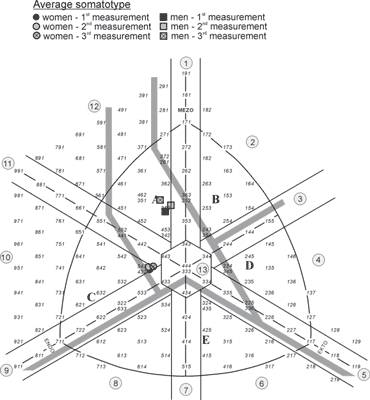
Fig. 1. The average somatotypes in groups
Male students on average seem in terms of constitution to be endomorphic mesomorphs. In this category, there are 50 % somatotypes; 43 % belong to the category of balanced mesomorphs. Within individual years, we can see the shift of an average somatotype in a vertical direction, which represents an individual increment of the mesomorphic component in 50 % of the male students. Female students may be evaluated as mesomorphic endomorphs, although on the borders with balanced endomorphs and mesomorphs-endomorphs. 31.5 % of female students belong to the lower part of the somatograph – with a very low level of mesomorphia. An additional 26.3 % of the file seems to be of moderate type, and 36.78 % are found in the category of mesomorphs-endomorphs. A constitutional shift during the studies in female students takes place mainly in the horizontal direction.
The resulting analysis shows a high occurrence of muscle shortening of tonic muscles in male students, which affects predominantly flexion in the knee and hip joints and possibly of the foot.
Shortening of the coxa flexors in combination with shortening of the trunk erector causes specific predispositions to disturbance of dynamic stability, and the lumbar spine is extensively overloaded. If those shortenings are combined with weakened abdominal muscles, the imbalance in the spine area increases and the dynamic instability deepens. Shortening of the tensor fasciae latae muscle causes patella deviation and together with shortening of the rectus femoris muscle has a destabilising effect on the knee point (Table 2).
Table 2. The occurrence of tonic muscles shortening in beginning groups of male and female students
| Tonic muscles | Men 2004 | Women 2004 |
| Number (n) | (n=30, 1pr.=3.33%) | (n=20, 1pr.=5%) |
| n | % | n | % |
| m. iliopsoas - D | 10 | 33.33 | 9 | 45.00 |
| m. iliopsoas - S | 10 | 33.33 | 9 | 45.00 |
| m. rectus femoris - D | 27 | 90.00* | 14 | 70.00 |
| m. rectus femoris - S | 26 | 86.67* | 15 | 75.00 |
| m. tensor fasc. l.- D | 18 | 60.00** | 6 | 30.00 |
| m. tensor fasc. l.- S | 20 | 66.67** | 5 | 25.00 |
| m. triceps surae - D | 12 | 40.00** | 4 | 20.00 |
| m. triceps surae - S | 11 | 36.67* | 4 | 20.00 |
| mm. adductores - D | 7 | 23.33 | 4 | 20.00 |
| mm. adductores - S | 7 | 23.33 | 4 | 20.00 |
| mm. flexores genu-D | 30 | 100.00** | 16 | 80.00 |
| mm. flexores genu-S | 30 | 100.00** | 15 | 75.00 |
| m. pect. major - D | 17 | 56.67** | 8 | 40.00 |
| m. pect. major - S | 16 | 53.33** | 6 | 30.00 |
| m. erector spinae | 7 | 23.33 | 4 | 20.00 |
| test of arms-D down | 5 | 16.67 | 1 | 5.00 |
| test of arms-S down | 3 | 10.00 | 1 | 5.00 |
| m. trapezius - D | 15 | 50.00** | 7 | 35.00 |
| m. trapezius - S | 16 | 53.33** | 6 | 30.00 |
| trunk sideways - D | 0 | 0.00 | 2 | 10.00 |
| trunk sideways - S | 0 | 0.00 | 2 | 10.00 |
D – dexter,
S – sinister,
** – significant difference between gender,
p <0.01; * – significant difference between gender,
p <0.05
During the 2nd year of study, there was a decrease in the frequency of shortening of the aforementioned muscles due to contribution of compensatory exercises during the hours of physical training. At the end of application of compensatory exercises in the subsequent year, there was again an increase in shortening, especially in the rectus femoris muscle and triceps surae muscle (Figure 2).

Fig. 2. The comparison of the occurrence of tonic muscles shortening in male students
D – dexter, S – sinister, 1 – measurement I., 2 – measurement II., 3 – measurement III.
We determined the greatest frequency of shortening in the rectus femoris muscle in female students, which did not change during the study significantly. Significant improvement of the tonic muscles during the study was determined in the knee flexors, similarly as in the case of the iliopsoas muscle. Relatively stable shortening was found in the trapezoid muscles and trunk extensors, where the occurrence of shortening was not that striking (Figure 3).

Fig. 3. The comparison of the occurrence of tonic muscles shortening in female students
D – dexter, S – sinister, 1 - measurement I., 2 – measurement II., 3 – measurement III.
The analysis of tonic muscle state is complemented with weakening of the phasic muscles, eventually with the occurrence of compensatory motoric stereotypes. Deviations in participation of phasic muscles in specific motoric stereotypes have lower frequency in our groups, but nevertheless considerably affect particularly the motoric stereotype of walking and summarize spine instability (Table 3).
Table 3. The occurrence of phasic muscles weakening in beginning groups of male and female students
| Tonic muscles | Men 2004 | Women 2004 |
| Number (n) | (n=30, 1pr.=3.33%) | (n=20, 1pr.=5%) |
| n | % | n | % |
| m. rect. abd. - 1 | 7 | 23.33 | 4 | 20.00 |
| m. rect. abd. - 2 | 11 | 36.67 | 6 | 30.00 |
| m. rect. abd. - 3 | 12 | 40.00 | 9 | 45.00 |
| extension lower E-D | 0 | 0.00 | 0 | 0.00 |
| extension lower E-S | 0 | 0.00 | 0 | 0.00 |
| abduction lower E-D | 3 | 10.00 | 2 | 10.00 |
| abduction lower E-S | 1 | 3.33 | 1 | 5.00 |
| flexion of neck | 8 | 26.67 | 8 | 40.00 |
| push-up | 3 | 10.00 | 5 | 25.00 |
| abduction upper E-D | 21 | 70.00** | 7 | 35.00 |
| abduction upper E-S | 21 | 70.00** | 6 | 30.00 |
E – extremity,
D – dexter,
S – sinister, m. rect.
abd. – rectus abdominis muscle,
** – significant diference,
p <0.01
The weakening of abdominal muscles together with shortening of coxal joint flexors and trunk extensors causes an inclination to inappropriately perform motoric stereotype of trunk flexis in standing and sitting positions. Strengthening of the abdominal muscles increases the abdominal pressure; it relaxes and thus reduces the load on the lumbosacral juncture. Concerning the fact that abdominal muscles belong to the deep stabilising system, their strengthening causes significant stabilisation of the lumbar spine area [22, 23].
In phasic muscles in female students, there were significant changes in abduction of the upper limb, where the occurrence of substitution motoric stereotype in abduction decreased. Also the condition of the abdominal muscles and nuchal flexors improved.
In male students, rectus abdominis muscle weakening ranges in individual year-classes from 6.25 to 37.50 %. In female students we found weakening in the range from 5.26 % to 21.04 % (Figures 4 and 5).
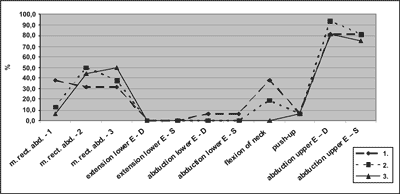
Fig. 4. The comparison of the state of phasic muscles and motoric stereotypes in male students
m. rectus abdominis 1 – weakened, 2 – good, 3 – excellent
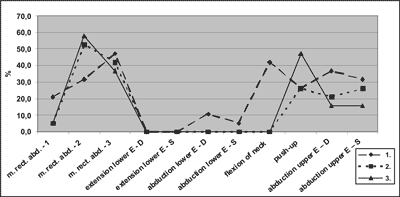
Fig. 5. The comparison of the state of phasic muscles and motoric stereotypes in female students
m. rectus abdominis 1 – weakened, 2 – good, 3 – excellent
In the motoric stereotype of lower limb extension, a substitution motoric stereotype dominates; higher frequency was determined in the male students. Extension of the lower limb in male students was realised to a greater extent during simultaneous activation of the muscles in the posterior side of the thigh and paravertebral muscles (Figure 6). The situation in female students was similar, with the exception of the 2nd year of measurement, where the paravertebral muscles were activated with greater frequency [24] (Figure 7).
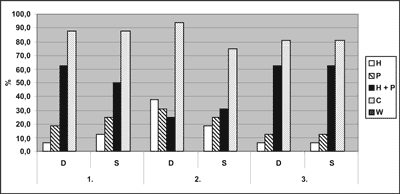
Fig. 6. The comparison of the motoric stereotype of lower limb extension from the aspect of participation of the individual muscular groups in male students
H – hamstrings, P – paravertebral muscles, C – compensatory stereotype in total, W – weakening
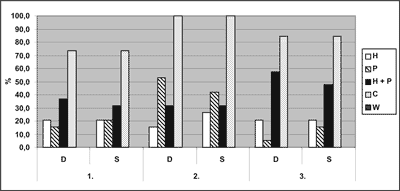
Fig. 7. The comparison of the motoric stereotype of lower limb extension from the aspect of participation of the individual muscular groups in female students
Hypermobility was diagnosed to a greater extent in the file of female students in comparison with male students. It was observed to a greater extent in the second measurement and that was in almost all muscle groups (result of compensatory exercises?). Also the muscle groups in male students appeared similar from the point of view of hypermobility (Table 4).
Table 4. The occurrence of hypermobility in groups of male and female students
| Hypermobility | M 1. | M 2. | M 3. | W 1. | W 2. | W 3. |
| m. pect. major - D | 6.25 | 25.00 | 12.50 | 15.78 | 42.08 | 26.30 |
| m. pect. major - S | 6.25 | 25.00 | 6.25 | 10.52 | 42.08 | 15.78 |
| m. erector spinae | 0.00 | 0.00 | 0.00 | 0.00 | 36.82 | 10.52 |
| test of arms-D down | 0.00 | 31.25 | 25.00 | 26.30 | 63.12 | 36.82 |
| test of arms-S down | 0.00 | 37.50 | 25.00 | 31.56 | 63.12 | 36.82 |
| trunk sideways - D | 31.25 | 37.50 | 50.00 | 47.34 | 47.34 | 57.86 |
| trunk sideways - S | 62.50 | 56.25 | 43.75 | 63.12 | 73.64 | 63.12 |
M 1. – measurement 1 – men, M 2. – measurement 2 – men, M 3. – measurement 3 – men, W - women
Discussion
As for hypokinesia and one-sided intensive endurance it is possible to consider movement activities as an ´unpleasant and unhealthy´ aspect of an active lifestyle which can result in disorders and, later, even in structural defects of the supporting-motoric system. The reversible changes in the structures of the given system will gradually result in pain problems and uneconomical movement forms [25].
The defective motoric stereotypes are beyond the biomechanical principles and are probably natural for each individual. Postural patterns are maintained by a complex arrangement of proprioceptive input, modified by habits, somatotype and psychogenic factors [26, 27, 28]. A defective posture can be manifested by dysfunction of the respiratory system and can have a negative influence on the psyche of an individual. The examination of postural and phasic functions in selected population groups should draw our attention to the given situation and try to force society to take up preventive activities starting in early childhood [9, 10]. Successful training is contingent on a number of factors. First and foremost is identification of the underlying muscle imbalance. Second, find the kinetic chain dysfunction (pathomechanics) responsible for the biomechanical overload. Third, address the key functional pathologies utilizing the continuum of care [29, 30, 31, 32, 33].
One-sided intensive motoric endurance is natural for active sportsmen and can also lead to a maladaptive influence on the supporting-motoric system. When it is not suitably complemented by an ideal rate of relaxation and stretching exercises, sportsmen are much inclined to injuries of muscle attachments, ligaments and joint capsule. The ´injured´, non-physiological joint is considered to be the limiting factor for reaching maximum sport performance in an individual. One-sided intensive pressure during the process of training is dangerous especially for children as there arises the danger of uneven development of determined physical fractions during ontogenesis [34].
As it results from the following analysis of the state of the muscular apparatus, balance in the function of phasic and tonic muscles is not very typical for the university population of FTK UP male and female students. From this imbalance we could deduce the assumption of an absence of correct body posture and incorrect performance of motoric stereotypes. Shortened muscles, as it appears from the presented results, have a dominant position in the development of muscular imbalances in students, and according to various authors they are the most frequent pathologic findings in the muscular system. This fact was confirmed especially in male gender [35, 36, 37].
Shortening of the trapezoid and pectoral muscles in students has a negative effect on movements of the shoulder girdle and cervical spine. Weakened phasic muscles in this area contribute to enhancement of upper cruciate syndrome. Increased shortening in pectoral muscles causes development of round shoulder, and possibly intensifies cervical lordosis, which supports incorrect posture in the nuchal area. Shortening of trapezoid muscles, which got worse during the studies, puts a great load on the shoulder girdle. In relation to the occurrence of shortened muscles in the shoulder girdle, we can find a relatively stable occurrence of substitution motoric stereotype in abduction of the upper limb, which subsequently increases instability in this area (upper body patterns), [9, 10].
Similar muscle imbalances are frequently found in the lumbar spine and pelvic region (lower body patterns). The lumbar erector spinae muscles are often tight and hypertonic, while the abdominal muscles are weakened. The hip flexor muscles get tight, while the gluteus maximus muscles become weak. This combination is suspected to be a contributing factor in hamstring muscle strains. Tight hip flexors will inhibit the hamstrings, which are under more stress during strenuous hip extension, since the glutei are not being much help. The result is excessive stress on the hamstrings, causing a sudden tear injury. Tight hip adductor muscles are frequently found in conjunction with weakness of the gluteus medius and minimus muscles; this can develop into a chronic groin strain [9, 10, 21, 38, 39, 40, 41].
Conclusion
– Shortened muscles, as it appears from the presented results, have a dominant position in the development of muscle imbalances in male students. We find in male students in general a very bad state of knee and coxal flexors. In male and female students we find the highest frequency of shortening in lower limbs in the rectus femoris muscle, tensor fasciae latae muscle, knee flexors (lower body patterns), and in the upper trunk in the trapezoid muscles. Shortening of trapezoid muscles puts a great load on the shoulder girdle.
– Deviations in participation of phasic muscles in specific motoric stereotypes have lower frequency in our groups, but nevertheless considerably affect particularly the motoric stereotype of walking and summarize spine instability.
– It is possible to diagnose a better postural muscle state in female students in comparison with the male population, as well as a statistically important difference concerning muscle groups except iliopsoas muscles, adductor muscles and paravertebral muscles. The female students have a better state of the supporting-motoric system, probably due to the broader spectrum of their physical activity, which is not so much of a strength type.
– Developing one´s muscles is the dominant part of physical activity of male students. Compensatory exercises are not a consistent part of our lifestyle. The positive effect of physical training with incorporated stretching exercises was confirmed in male students of the University of Defence in 2005. In 2006, when compensatory exercises were eliminated from the regular regime of physical training, the state of the supporting-motoric system in male students worsened, particularly in the lower limbs.
*Elaborated in terms of attaining the research plan "Physical activity and inactivity of the population in the Czech Republic in the context of behavioural transformation” (IK: 6198959221).
Piśmiennictwo
1. Přidalová M, et al.: Somatic characteristics in male and female students of the University of Defence in Brno and in FPC UP in Olomouc. In: Sokolowski M (Ed.): Kultura fizyczna w wojsku na poczatku XXI. Wieku. Poznań 2005, 200-209. 2.Pechtor P, et al.: Vliv obsahu tělesné přípravy na změny somatických znaků a růst funkční zdatnosti studentů Univerzity obrany v Brně. Slov. Antropol. 2005, 8 (2), 111-115. 3.Bouchard C, Shephard RJ: Physical aktivity, Fittness and Health - Consensus Statement, Champaign 1993, 11, IL: Human Kinetics. 4.Přívětivý L: Motion activities and testing of physical efficiency in the Czech Army Professionals. In: Vaverka F (Ed): Movement and Health. Olomouc 2005, 390-394. 5.Sokolowski M: The level of physical fitness of cadets of the land forces in a 4-year course of observation. Česká antropologie 2006, 56, 122-124. 6.Krejčovský L, et al.: Somatické charakteristiky studentů 1. ročníku PdF UP Olomouc. Česká antropologie 2001, 51, 94-97. 7.Karpljuk D, et al.: The effect of individually designed programs of physical training based on US Army standards on motor abilities of slovene armed forces personnel. Acta Universitatis Palackianae Olomucensis Gymnica 2006, 36 (1), 29-36. 8.Gröger A, et al.: Anthropometrie und Muskelkraftmessung bei deutschen männlichen Junioren-Hockeynationalspielern Sportschaden 2001, 15 ( 4), 87-91. 9.Kapandji IA: Funktionelle Anatomie der Gelenke. Ferdinand Enke Verlag, Stuttgart 1992. 10.Kendall FP, et al.: Muscles, testing and functions. Williams and Wilkins, Baltimore 1993. 11.Luttgens K, Hamilton N: Kinesiology: scientific basis of human motion. WCB/McGraw-Hill, Boston 1997. 12.Přidalová M: A comparison of czech and polish students in terms of muscle function. Acta Universitatis Palackianae Olomucensis Gymnica 1999, 29, 25-34. 13.Přidalová M, et al.: Muscles function and Movement stereotypes of students at Fakulty of Physical Culture in Olomouc. In: Vaverka F. (Ed): Movement and Health. Olomouc 2005, 167-168. 14.Přidalová M, et al.: The effect of targeted physical activity of an aerobic type on the state of muscular functions in women at the age of Maturus I. and II. Studies in Physical Culture & Tourism 2006, XIII. (1), 77-79. 15.Přidalová M, et al.: Functionality of the supporting movement systém as one of the parameters for on optimally functioning body diagram. In: Sokolowski M (Ed.): Kultura fizyczna w wojsku w dobie przemian. Poznań 2002, 226-237. 16.Dostálová I, Miklánková L: Protahování a posilování pro zdraví. Hanex, Olomouc 2005. 17.Gualdi-Russo E, Zaccagni L: Somatotype, role and performance in elite. Sports Med. Phys. Fitness 2001, 41(2), 256-62. 18.Kutáč P, Dobešová P: Svalové dysbalance studentů tělesné výchovy v letech 2000/2001. In: Riegerová J (Ed.): Diagnostika pohybového systému. Metody vyšetření, primární prevence, prostředky pohybové terapie. Olomouc 2002, 87-89. 19.Kutáč P, Dobešová P: Hodnocení tělesné stavby studentů 1. Ročníku oboru tělesná výchova na PdF OU Ostrava. Česká antropologie 2001, 51, 116-118. 20.Dostálová I, Aláčová Gaul P: Vyšetřování svalového aparátu. Hanex, Olomouc 2006. 21.Janda V, et al.: Svalový test. Avicenum, Grada Publishing, Praha 2004. 22.Panjabi M, White AA.: Biomechanic in the musculosceletal system. Churchill Livingstone, USA 2001. 23.Travell JG., Simons, DG.: Myofascial pain and dysfunction. The trigger point manual. Williams and Wilkins, Baltimore 1992. 24.Yanac-Parades E, et al.: The assessment of stereotype of hip extension usány palpation and surfaře electromyography methods. In: Vaverka F (Ed): Movement and Health. Olomouc 2005, 127. 25.Barkin RL, et al.: Management of chronic pain. Part II. Dis Mon 1996, 42 (8), 457-507. 26.Christensen K: Manual muscle testing and postural imbalance. Dynamic Chiropractic 2000, 18 (16), 199-202. 27.Panzer DM, et al.: Postural komplex. In: Gatterman MI: Chiropractic management of spine related disorders. Williams & Wilkins, Baltimore 1990. 28. Lewit K: Chain reactions in the locomotor system: coactivation patterns based on development neurology. J Orthop Med 1999, 22, 52-57. 29.Norris CM.: Spinal stabilisation. 1. Active lumbar stabilisation - concepts. Physiotherapy 1995, 81(2), 61-64. 30.Norris CM: Spinal stabilisation. 2. Limiting factors to end-range motion in the lumbar spine. Physiotherapy 1995, 81(2), 64-72. 31.Norris CM.: Spinal stabilisation. 3. Stabilisation mechanisms of the lumbar spine. Physiotherapy 1995, 81(2), 72-79. 32.Norris CM: Spinal stabilisation. Muscle imbalance and the low back. Physiotherapy 1995, 81(3), 127-138. 33.Norris CM: Spinal stabilisation. An exercise program to enhance lumbar stabilisation. Physiotherapy 1995, 81(3),138-46. 34. Bruns D, Disorbio JM: Battery for Health Improvement 2 (BHI 2) Manual. Minneapolis, MN: NCS Pearson, Inc., 2003. 35.Geraci M, Brown JRW: Evidence-Based Treatment of Hip and Pelvic Injuries in Runners. Physical Medicine and Rehabilitation Clinics of North America, 16 (3), 711-747. 36.Schache A, et al.: Differences between the sexes in the three-dimensional angular rotations of the lumbo-pelvic-hip complex during treadmill running. Journal of Sports Sciences 2003, http://www.informaworld.com/smpp/title~content=t713721847~db=all~tab=issueslist~branches=21 - v2121 (2), 105-118. 37. Akuthota V, Nadler S: Core strengthening. Arch Phys Med Rehabil 2004, 85 (1), 86-92. 38. Geraci MC: Rehabilitation of the hip, pelvis, and thigh. In: Kibler WB (Ed.): Functional rehabilitation of sports and musculosceletal injuries. Gaithersburg. 39.Griegel-Morris P, et al.: Incidence of common postural abnormalities in the cervical, shoulder, and thoracic regions and thein association with pain in two age groups of healthy subjects. Phys. Therapy 1992, 72, 425-431. 40.Lewitt K: Manipulační léčba. J. A. Barth Verlag, Heidelberg - Leipzig 1996. 41.Geraci MC: Rehabilitation of the hip and pelvis. In: Kibler WB, Herring SA, Press JM (Eds.): Functional Rehabilitation of Sports and Musculoskeletal Medicine. Frederick, MD: Aspen Publisher, 1998, 216-243.
Adres do korespondencji:
*Miroslava Přidalová
Department of Functional Anthropology and Physiology,
Faculty of Physical Culture, Palacký University
Tř. Miru 115
771 11 Olomuc, Czech Republic
tel.: (+420) 58 563 61 58
e-mail: miroslava.pridalova@upol.cz
New Medicine 3/2007Strona internetowa
czasopisma New MedicinePozostałe artykuły z numeru 3/2007:






